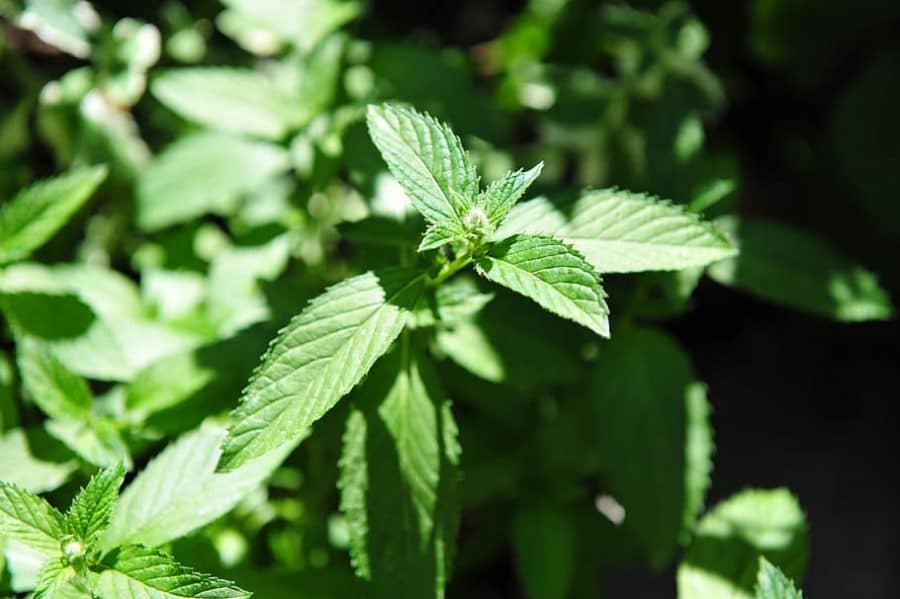Quick Facts About Scent Leaf
| A | B |
|---|---|
| Name | Scent leaf |
| Scientific Name | Ocimum gratissimum |
| Origin | Native to Africa, Madagascar, southern Asia, and the Bismarck Archipelago |
| Family | Lamiaceae (mint family) |
| Habitat | Thrives in warm, humid climates, often found in forests, along roadsides, and in home gardens |
| Appearance | Aromatic shrub with ovate to lanceolate leaves, ranging from 1 to 4 inches in length |
| Common Names | African basil, clove basil, scent leaf, licorice basil, holy basil |
| Aroma | Intensely fragrant, with a clove-like scent |
| Flavor | Warm, spicy, and slightly licorice-flavored |
| Culinary Uses | Widely used in West African cuisine, adding a unique flavor to soups, stews, meat dishes, and vegetables |
| Medicinal Properties | Traditionally used to treat various ailments, including fever, malaria, stomach upset, and respiratory infections |
| Nutritional Value | Rich in vitamins A, C, and K, as well as minerals such as calcium, iron, and magnesium |
| Name in Other Languages | • French: Basilic africain • Spanish: Albahaca africana • Portuguese: Manjericão africano • Italian: Basilico africano • German: Afrikanisches Basilikum • Arabic: حبق العش • Chinese: 土丁香 • Japanese: ホーリーバジル • Korean: 호랑이바질 • Russian: Африканский базилик • Hindi: अफ्रीकी तुलसी • Tamil | ஆப்பிரிக்கன் துளசி • Telugu: ఆఫ్రికన్ తులసి • Malayalam: ആഫ്രിക്കൻ തുളസി • Kannada: ಆಫ್ರಿಕನ್ ತುಳಸಿ • Bengali: আফ্রিকান তুলসী • Marathi: आफ्रिकन तुळस • Gujarati: આફ્રિકન તુલસી • Punjabi: ਅਫ਼ਰੀਕੀ ਤੁਲਸੀ • Edo: Ebe-amwonkho • Fon: Tchayo • Yoruba: Efirin • Igbo: Nchanwu • Igala: Añyeba • Hausa: Daidoya • Jamaica: Nunu Bush • Haiti: Fobazen • Uganda: Mujaaja |
Every month, women around the world have that time they sometimes wish would go easier for them, prompting them to ponder on ideas like; does scent leaf and menstruation have a relationship? This probably started when some women noticed certain changes in their monthly flow, and the one thing they’ve done differently is to use scent leaf.
Scent leaf has many health benefits, ranging from improving vision, to lowering blood sugar level, aiding digestion, repelling insects and mosquitoes, and soothing inflamed tissues, among others. It contains phytochemicals that help it exert these medicinal properties and make symptoms easier to bear. Recently, there has been an increase in the desire to know how scent leaf affects menstruation.
In this article, we will help you breakdown the connection that probably exists between scent leaf and menstruation. However, to do this, we will have to expose its effect on ovulation and the hormones that help to regulate the monthly business of women. Also, you will get to know the biological contents of scent leaf, that makes it have an effect on menstruation and ovulation.
What Exactly is Scent Leaf?
You can’t miss it. The characteristic aromatic smell and taste that is attributed to the scent leaf, popularly called efirin in the south western part of Nigeria, makes it distinct. Its leaves vary in size but are usually small and can range from light to deep green in coloration. They can grow as tall as 2m, depending on the fertility of the soil they are planted in.
Related Article: Is Scent Leaf Good for Babies?
Scent leaf is common in many homes and is widely used to address many gastrointestinal issues. It serves as a good first aid for stomach upsets, hence its presence in many homes. Also, some people use it as part of their spice in cooking soups and stews. However, it is unclear if scent leaf affects the female gender in regards to their menstruation and ovulation.
Understanding Menstruation
Menstruation is the monthly discharge of blood and other endometrial tissues from the uterus through the vaginal opening. It is the time of the month when women shed the endometrial layer that have developed in preparation for implantation of fertilized matured eggs from the ovary.

Menstruation usually occurs between the 14th and 21st day of the menstrual cycle and can last for four days or more. It is accompanied by some symptoms, which give rise to premenstrual syndrome, PMS. However, it is important to note that menstruation during the menstrual cycle depends on the balance of certain hormones in the female body.
The important hormones that influence regular menstruation include estrogen, progesterone, follicle stimulating hormone, and luteinizing hormone. These hormones have to be in certain proportions to one and another, and in response to their levels, the endometrium breaks down and is shed as waste through the vagina opening.
The menstrual cycle involves three stages: the follicular, ovulatory, and luteal stages. Each stage is defined by egg release. The follicular stage is the stage when eggs are yet to be released from the ovary; the Ovulatory stage is the egg release stage; and the Luteal stage is the stage that comes after egg release. In essence, menstruation happens in the luteal stage of the menstrual cycle.
During the luteal stage, the levels of the luteinizing and follicle stimulating hormones are low because the ovary (where they are produced) closes up and forms the corpus luteum. However, the levels of progesterone and estrogen increases, making the uterine lining thicken in anticipation of fertilized egg implantation. If the egg is not fertilized, the uterine lining disintegrates due to a decreased amount of progesterone from the corpus luteum.
In essence, if progesterone level remains high, the uterine lining will remain intact, and no menstrual flow will occur. However, if it decreases, the uterine lining breaks down and is ejected from the body as part of the menstrual blood.
Biochemical and Nutritional Constituents of Scent Leaf
In scent leaf, as in other plants, there are nutrients and biochemicals that help them exert their medicinal benefits to the human body. Do the nutrients contained in scent leaf have an effect on the progesterone level in the female human body? Do the phytochemicals affect the endocrine system in relation to menstruation?
The nutrients and phytochemicals in scent leaf include:
| Constituent | Composition (Mg/Kg) |
| Magnesium | 1.71 |
| Manganese | 0.46 |
| Lead | 0.005 |
| Potassium | 0.26 |
| Calcium | 0.14 |
| Zinc | 0.20 |
| Nitrogen | 0.29 |
| Copper | 0.80 |
| Iron | 0.31 |
| Sodium | 0.31 |
| Steroid | Present |
| Alkaloids | Present |
| Saponins | Present |
| Tannins | Present |
| Flavonoids | Present |
| Terpenoids | Present |
| Glycosides | Present |
Source: Researchgate
How Do Scent Leaf and Menstruation Relate?
Scent leaf and menstruation only have relation in how nutrients influence the production and levels of hormones in the human body. Scent leaf does not directly contain progesterone that it will influence the menstrual cycle by causing the uterine lining to remain intact or make it break down as soon as possible. However, it contains some nutrients that influence the production of progesterone.
Scent leaf is rich in zinc and contains 0.20 mg per kg, a little more than the WHO recommendation of 0.16 mg per kg. the presence of zinc in scent leaf ensures that the pituitary gland produces adequate amount of follicle stimulating hormone which while still present in the female body, causes an increased progesterone level. As long as the progesterone level in the body is high, the uterine lining assumes pregnancy is imminent and does not break down, thus delaying menstruation.
Magnesium is another nutrient that increases the levels follicle stimulating hormone and consequently, progesterone and estrogen. Scent leaf contains 1.71 mg per kg and WHO recommends 0.62 mg per kg.
How Often Should a Female Use Scent Leaf?
Zinc and Magnesium in scent leaf may have some effect on menstruation and the menstrual cycle by influencing the production and levels of progesterone and estrogen in the female body. However, it can be beneficial, and the other hand, cause disruptions in the monthly cycle.
To get the best out of the nutrients that scent leaf gives in relation to menstruation, increase its consumption during other times in your menstrual cycle, apart from the luteal stage. That is, eat as much scent leaf as you can during your safe and ovulation periods but reduce its consumption to the minimum when you approach the menstrual period.
Conclusion
Scent leaf and menstruation have a relationship in how the nutrients – zinc and magnesium – in the aromatic plant influence the levels of female sex hormones – estrogen and progesterone – in the body. The nutrients cause an increase in estrogen and progesterone and prevents the uterine wall from breaking down to give the monthly menstrual flow.
A reduction in the amount of scent leaf a female consumes during the menstrual period may help the uterine wall break down sooner, facilitating adherence to regular menstrual cycle.

Ayomide is a fiction and non-fiction writer. A lover of science and everything mysterious that surrounds it, he seeks out new information to keep his interest alive.
The content is intended to augment, not replace, information provided by your clinician. It is not intended nor implied to be a substitute for professional medical advice. Reading this information does not create or replace a doctor-patient relationship or consultation. If required, please contact your doctor or other health care provider to assist you to interpret any of this information, or in applying the information to your individual needs.


